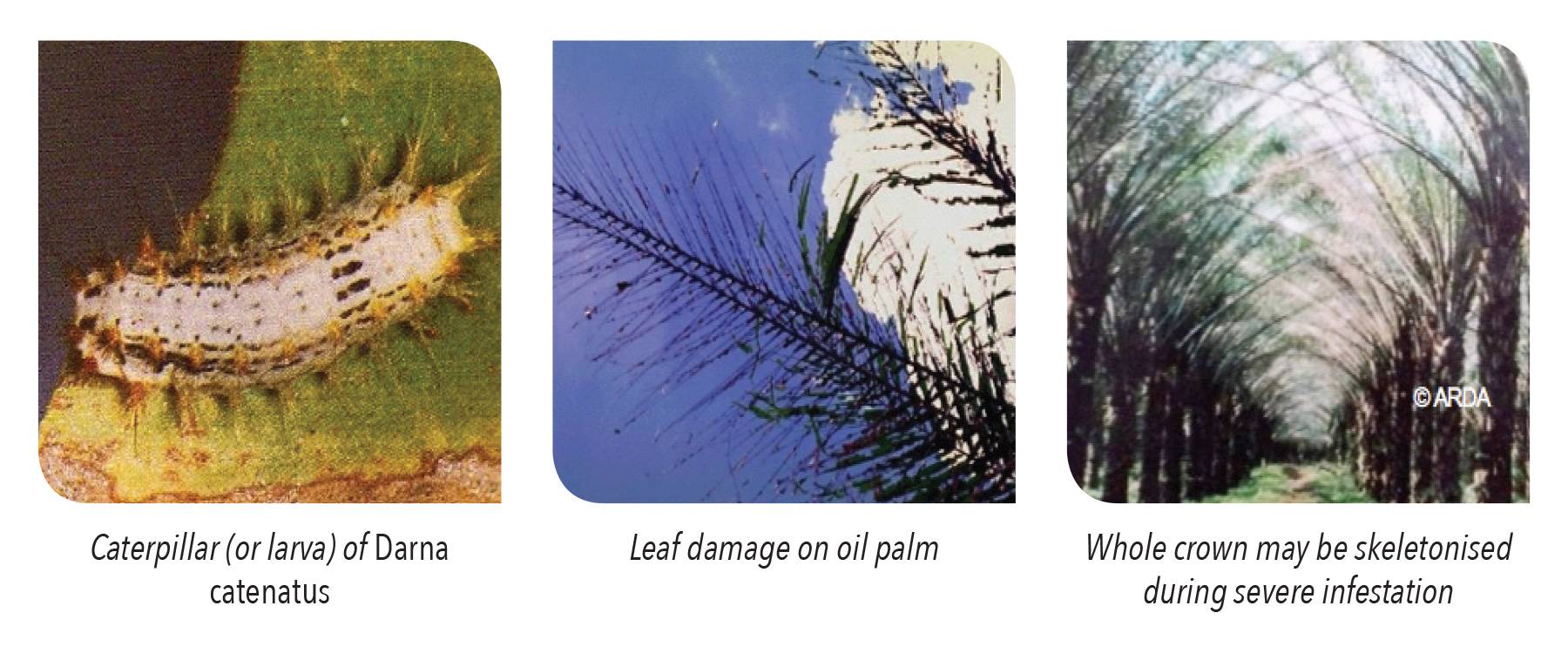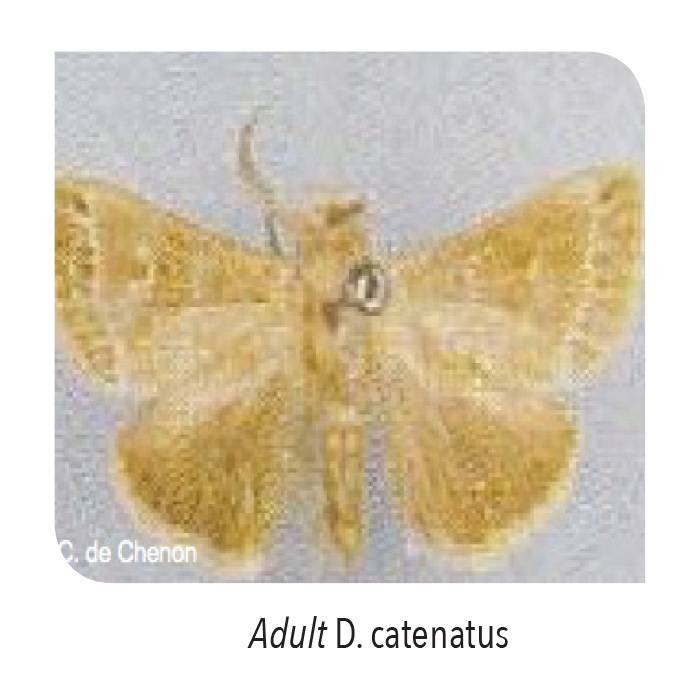General Information
The larvae or caterpillar of Darna catenatus causes severe defoliation on oil palm. The caterpillars usually feed on the underside of leaves. The young caterpillars often strip the leaf surface to feed, while the older caterpillars eat away the whole leaf, leaving only the midrib. The entire crown of the palm may be defoliated during severe out-breaks. Severe defoliation, particularly of the young leaves, may affect the yield of fresh fruit bunches (FFB). Out-breaks usually develop on small groups of palms or on isolated tree. Feeding damage is accentuated by invasion of Pestalotiopsis palmarum. Heavy infestations on coconut trees result in nut fall and the trees take 1.5-2 years to recover.

First symptom of Pestalotiopsis leaf spot is the development of small brown spots with yellowish haloes. As the disease progresses, the spots coalesce into brown necrotic areas that spread throughout the leaves. The leaves eventually turn grey and brittle. The condition can occur at any stage of the palm, but is generally more severe in plantations over five years and can cause higher production reductions (up to 36% due to decline in photosynthetic capacity of the leaflets). Bunch reduction of as much as 18 to 20 t/ha, and crop loss of up to 40% due to this disease have been recorded. D. catenatus is a serious pest during dryer months. Although the coconut palm is the principal host plant, outbreaks have also been observed in sago and oil palm plantations. In addition to palm damage, D. catenatus also pose health risks to infested areas. The caterpillars have stinging spines that can cause painful injury to plantation and nursery workers, and irritation (or allergies to sensitive individuals).
D. catenatus is a serious pest during dryer months. Although the coconut palm is the principal host plant, outbreaks have also been observed in sago and oil palm plantations.
In addition to palm damage, D. catenatus also pose health risks to infested areas. The caterpillars have stinging spines that can cause painful injury to plantation and nursery workers, and irritation (or allergies to sensitive individuals).
Distribution
Indonesia (Irian Jaya, Sulawesi); India (Andhra Pradesh).
Detection and Inspection
ADULT MOTHS
Up to 12 mm in size. Pale yellowish brown forewing, uniform apart from a regular dark marginal band and a faint discal spot; the hindwings are dark grey-brown.
COCOONS
Oval, nearly spherical, light brown in colour and embedded in loose pale silk. It measures 7-7.5 x 5.0 mm and in formed in the crown of the palm, or on the leaflet undersurface.
LARVAE
Young larvae: The first two instars are green.
Midgrown larvae: Dark dorsal line with a blusih or violet sheen, and a paler central line. It is narrow in the middle.
Mature larvae: Up to 14.5 mm long. Oblong, only prothorax greenish. White colour with a black stripe that is much more distinct in young larvae. The rows of spines are small and uniform in size.
EGGS
Very small. Laid singly or in pairs on the undersurface of leaflets, especially towards the tip of the leaves. Females lay up to 300 eggs.

Prevention and Control
PHYTOSANITARY
Eggs and young larvae are difficult to detect via visual inspection. Only the larger mature larvae or adult moths are more likely to be detected. Cocoons may be contaminant in seed lots. Therefore, ensure source of germplasm from pest free areas. Proper sanitation from sourcing to shipping is crucial. The import of germplasm material (seeds, pollen, tissue culture) must be accompanied by an import permit issued by or on behalf of the Director-General of Agriculture for Peninsular Malaysia (including Labuan), or the Director of Agriculture for Sabah, and a phytosanitary certificate issued by an authorised official from the country of export. The import conditions are available upon request from the Plant Biosecurity Division Malaysia. All consignments are subjected to inspection by the Agricultural Department prior to clearance by Customs. Germplasm material imported from high risk areas should be sent for third country quarantine before arrival onto Malaysian shores. The import of alternative host plant parts i.e. Antidesma spp., Cocos nucifera and Salacca zalacca from infested areas should be enquired with DOA.
CULTURAL CONTROL AND SANITARY METHODS
Conduct regular surveillance system to detect population spikes, and destroy centers of infestation. Plantations to be inspected regularly every 2 months: fronds to be destroyed immediately upon detection of larvae.
Further reading
- Brill, E J (1969). Use of Pesticides and Control of Economic Pests and Diseases in Indonesia. Leiden: The Netherlands. p. 50-51.
- CABI CPC (2015). Datasheet on Darna catenatus. URL: www.cabi.org/cpc/
- Corley, R H V and Tinker, P B (2003). The Oil Palm 4th ed. Blackwell Science Ltd: USA. p. 433-434.
- Cock, M J W; Godfray, H C J and Holloway, J D (1987). Slug and nettle caterpillars: The biology, taxonomy and control of the Limacodidae of economic importance on palms in South-east Asia. CAB International: UK. p. 98- 99.
- Davis, T A and Sudasrip, H (1982). Causes for the defoliation of coconuts in Indonesia. Indonesian Agric. Res. Dev. J. 4: 8-29.
- Kalidas, P and Saravanan, L (2013). Natural enemies of oil palm defoliators and their impact on pest population. Pest Manag. Hortic. Ecosyst 19(2): 179-184.
- Ponto, S A S and Mo, T T (1950). The control of Darna catenatus (Sn.) on coconut trees in the Palu valley, Central Celebes. Landbouw, 22: 69-81.

